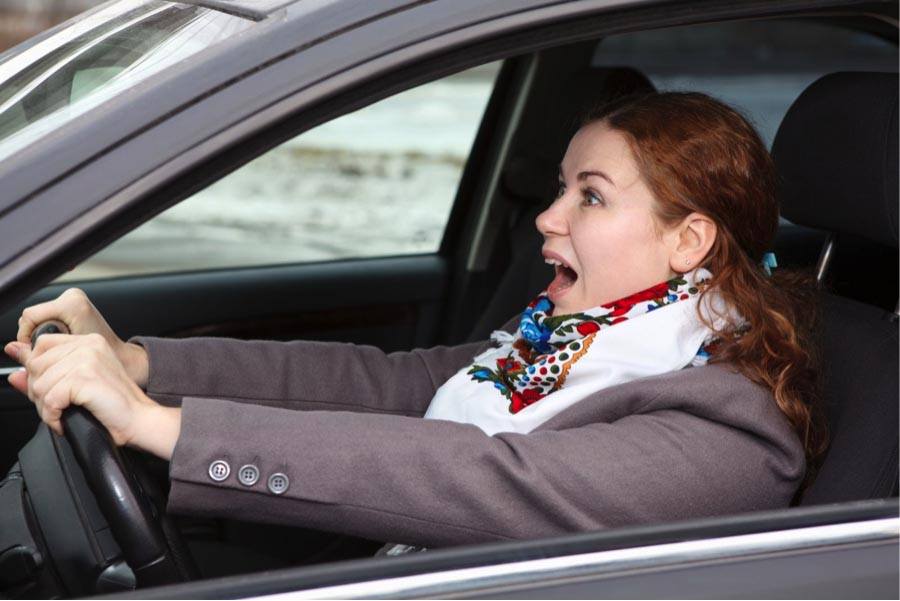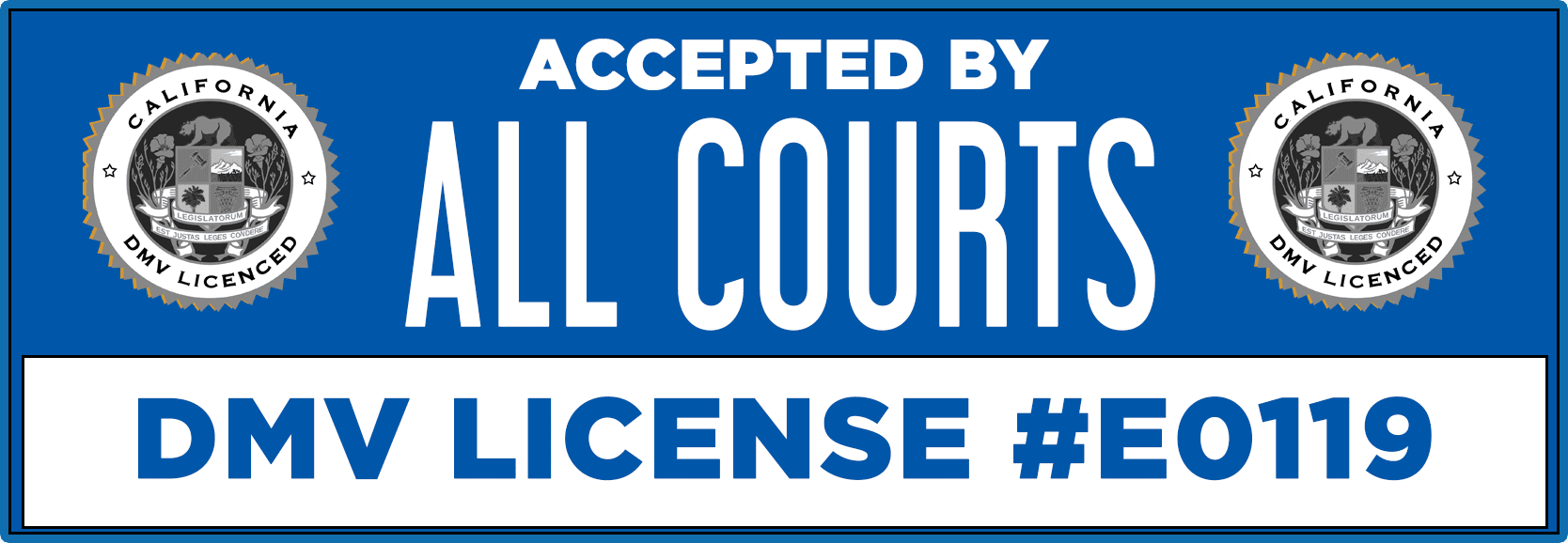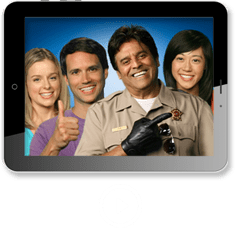When Is It Safe To Brake?
Speed and Stopping Distances

There are three things that add up to total stopping distance: Perception Distance + Reaction Distance + Braking Distance = Total Stopping Distance.
Perception distance. This is the distance your vehicle moves from the time your eyes see a hazard until your brain knows it. The perception time for an alert driver is about 3/4 of a second. At 55 mph you travel 60 feet in 3/4 of a second.
Reaction distance. The distance traveled from the time your brain tells your foot to move from the accelerator until your foot is actually pushing the brake pedal. The average driver has a reaction time of 3/4 of a second. This accounts for an additional 60 feet traveled at 55 mph.
Braking distance. The distance it takes to stop once the brakes are put on. At 55 mph on dry pavement with good brakes, it can take a heavy vehicle about 170 feet to stop. (About 4 and 3/4 seconds.)
Total stopping distance. At 55 mph it will take about 6 seconds to stop and your vehicle will travel about the distance of a football field (60 + 60 + 170 = 290 feet).
By the time your foot hits the brake, your vehicle has traveled about as many feet forward as the number of miles per hour you are traveling.
REACTION TIME: Use your foot to “cover the brake” as you proceed through an intersection. By covering the brake pedal, you significantly reduce the reaction time necessary to respond to a hazard and also allow the vehicle to slow by removing your foot from the accelerator. The “covering the brake” technique can be used effectively in the following situations: (1) When driving next to parked cars, (2) when you see the brake lights of other cars, and (3) when approaching intersections or signal lights.
If you are traveling at 50 miles per hour, it will take 50 feet just for you to react and put your foot on the brake. Of course, the stopping distance varies depending on the surface of the road, the condition of the brakes, and the skill of the driver in recognizing and reacting to hazards.
Factors that Affect Stopping Distance
Road Conditions
Wet or Icy Roads: Water and ice create a slippery surface that reduces the tires’ grip on the road, making it harder to stop. For example, if you drive at 55 mph on a dry road, you have a stopping distance of around 290 feet. However, this distance can increase to over 400 feet on a wet road, and on icy roads, it can double or even triple. For this reason, reducing your speed and maintaining a safe following distance in these conditions is crucial to ensure you have enough room to stop.
Gravel or Loose Surfaces: Loose surfaces like gravel or sand will also affect stopping distances. These surfaces provide less traction than paved roads, causing the vehicle to skid, resulting in a 20-30% longer stopping distance.
Vehicle Conditions
Tire Condition: The condition of your tires is crucial for your stopping distance as they provide traction to the road. Your tires should have a minimum tread depth of 2/32 inches to ensure that you can stop in time.
Brake Maintenance: Regular brake maintenance is essential for effective stopping. For example, if your brake pads are worn down, it can take an additional 50-100 feet to stop at 55 mph. Regularly checking and maintaining your brakes can help ensure they function correctly when needed.
Driver Conditions
Fatigue: Fatigue will significantly increase reaction times and perception distance. A tired driver can take up to 1.5 seconds to react to a hazard, compared to the typical 0.75 seconds. At 55 mph, this difference can add an extra 60 feet to your stopping distance. So, it’s vital that you take regular breaks and ensure you are fully-rested before driving.
Distractions: Distractions such as using a mobile phone, eating, or adjusting in-car entertainment will also delay reaction times. A distracted driver might take an additional 0.5 seconds to react, increasing your stopping distance by 40 feet at 55 mph. Minimize distractions and stay focused on the road to help reduce the risk of accidents.
Advanced Braking Techniques
Threshold Braking
Threshold braking involves applying the brakes firmly to the point just before the wheels lock up. This technique maximizes braking force while maintaining control of the vehicle. For example, when you need to stop quickly on a dry road, applying threshold braking can help you stop within the shortest distance possible without the danger of skidding.
Anti-Lock Braking Systems (ABS)
ABS prevents the wheels from locking up during hard braking, allowing the driver to maintain steering control. When ABS activates, you might feel a pulsating sensation in the brake pedal—this is normal. Always apply firm, continuous pressure on the brake pedal when ABS is activated.
Emergency Situations
Evasive Maneuvers
In some situations, swerving around an obstacle may be safer than attempting to stop in time. For example, if a vehicle suddenly stops in front of you and you have no room to brake, quickly checking your mirrors and swerving to an empty lane can prevent a collision.
Skid Control
Different types of skids require different responses:
- Front-Wheel Skid: Release the accelerator and steer in the direction you want to go. Avoid braking.
- Rear-Wheel Skid: Steer in the direction of the skid to regain control, then steer back to keep the vehicle straight.
- Four-Wheel Skid: Ease off the accelerator and brake gently to regain traction.
Legal and Safety Considerations
Following Distance
Maintaining a safe following distance is crucial for avoiding rear-end collisions. The general rule is to keep a distance of at least three seconds between your vehicle and the one in front of you. In poor weather conditions, increase this to four or five seconds.
Speed Limits
Speed limits are set based on road conditions, traffic patterns, and safety considerations. Driving above the speed limit reduces your reaction time and increases stopping distances. For instance, if you drive at 65 mph in a 55 mph zone, your stopping distance should increase by nearly 100 feet. Always obey speed limits and adjust your speed according to road and traffic conditions.
Educational Resources
Simulation and Practice
Using driving simulators and practicing braking techniques in a controlled environment to help familarize yourself with different breaking techniques. Simulators can replicate various road conditions and scenarios, allowing you to practice and develop muscle memory for different braking techniques.
Frequently Asked Questions (FAQs)
What is the safest way to brake in an emergency?
The safest way to brake in an emergency is to apply firm, continuous pressure on the brake pedal, especially if your vehicle is equipped with ABS. If your vehicle does not have ABS, use threshold braking—apply the brakes firmly but avoid locking the wheels. In both cases, try to steer around obstacles if possible.
How does vehicle load affect braking distance?
Carrying a heavy load will increase your vehicle’s stopping distance as the added weight puts more strain on the brakes and reduces the vehicle’s ability to stop quickly. For example, a fully loaded truck may take an additional 50-100 feet to stop compared to an empty one. If you are carrying a heavy load, increase your following distance and reduce your speed.
What should I do if my brakes fail?
If your brakes fail, follow these steps:
- Stay Calm: Panic can make the situation worse.
- Pump the Brakes: Pumping the brake pedal rapidly can help build up enough pressure to stop the vehicle.
- Use the Emergency Brake: Gradually apply the emergency brake to slow down.
- Downshift: Shift to a lower gear to use engine braking.
- Find a Safe Area: Look for a safe area to pull over, such as a flat, open space.
When you enroll in a traffic school program, you will learn about the topics mentioned above and more. A motor vehicle can be a safe mode of transportation, or it can be a very dangerous weapon. If you want to learn how to increase the chances of making it to your destination in one piece, complete our traffic school online today. The program is ComedyTrafficSchool.com. Take online traffic school the fun way with our award winning course. Our traffic school course is the perfect choice for anyone who recently received a traffic ticket; keep points masked from your driving record, your auto insurance rates low and become a better, safer driver!





